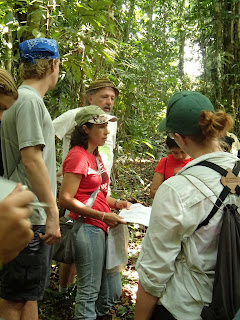“By the tender mercy
of God, the dawn from on high will break upon us, to give light to those who
sit in darkness and in the shadow of death, to guide our feet into the way of
peace.”
~Luke 1:78-79
After our stay in Peñas Blancas, we hiked out another 10
miles to Pocosol (little sun).
Despite the name, our stay was rather nice and it only rained a bit in
the afternoons and evenings. The
hike began with a descent river crossing.
So a hope of dry boots for the hike was pretty much non-existent.
 |
| We found an armadillo skeleton in the trail! |
The hike to Pocosol was much like the first; lots of green in all directions, and water everywhere. I didn’t take many pictures. Mostly we just walked in the rainforest. When we were almost there, we came to a small pond with refreshing water and so I jumped in, boots and all! (I did take my backpack off first…) I figured everything was already soaked so it didn’t really matter all that much. The station we stayed at was very nice, and had electricity in the evenings so we didn’t eat dinner by candlelight as we had in Peñas Blancas.
 |
| The station (with Johel's reflection in the window) |
 |
| View from the porch |
As you can see, the view from the station was nice and open. This doesn’t happen much in the rainforest as everything is so grown up that you can’t see very far. Here however, trees had been cleared and the station sat on a small hill. This made for excellent bird viewing, which is why we had Bird Diversity Day here. This consisted of a series of lectures, some bird walks (I can’t remember what we saw though…), practicing identifying birds by their calls, and some live demonstrations by our resident bird expert Johel.
 |
| Green Hermit (Hummingbird) |
My favorite activity of the day was “casual afternoon birding from the porch.” It was a very relaxing day (an anomaly here) and we saw many different species of hummingbirds, wrens, oropendalas, trogons, and I forget what else. The next morning I woke up super early like I usually do, and about eight toucans landed in a tree near the station! That was super cool, and probably the highlight of my time in Pocosol. Most of them were Keel-Billed Toucans, but one was a Chestnut-Billed Toucan.
Our second night in Pocosol we had a stats lecture to
prepare for data analysis for our independent research projects. We learned the difference between a
regression and a correlation.
Then, since this is an experiential learning program, we had to
demonstrate. So we gathered data
and determined the regression for our ability to taste expensive rum. Not even kidding. Turns out I don’t like rum. I do however have statistically
significant good tastes and was able to correctly identify the $60 bottle of 23
year aged rum as my favorite. Only
in Costa Rica…
Our final day in Pocosol we walked around and learned about
some of the different plant species growing in the area.
 |
| Class |
 |
| A cool spider |
After our lectures, we hopped in the back of a truck and rode out on some sketchy, very steep, very rocky roads. It made for an adventure!



































